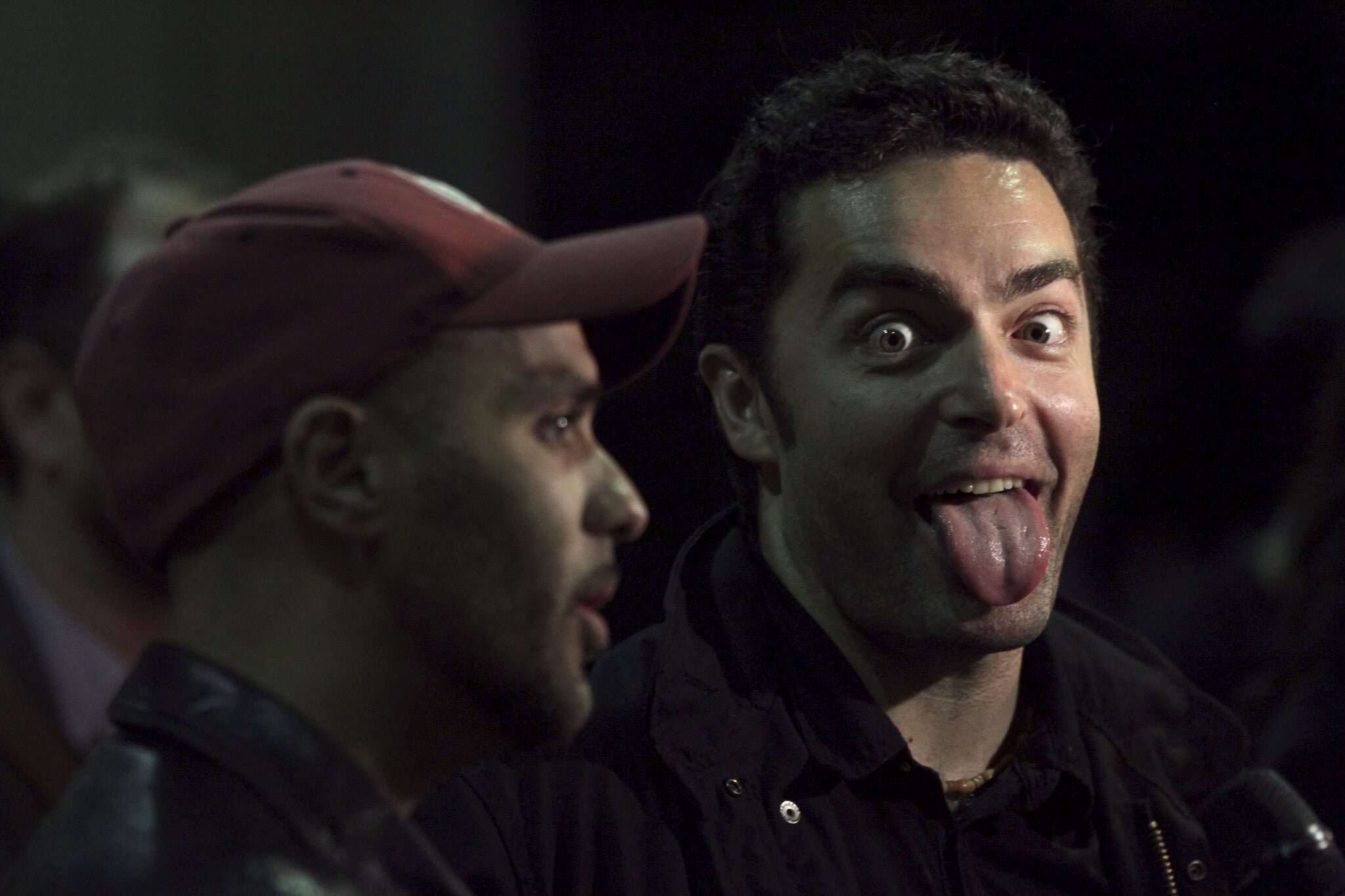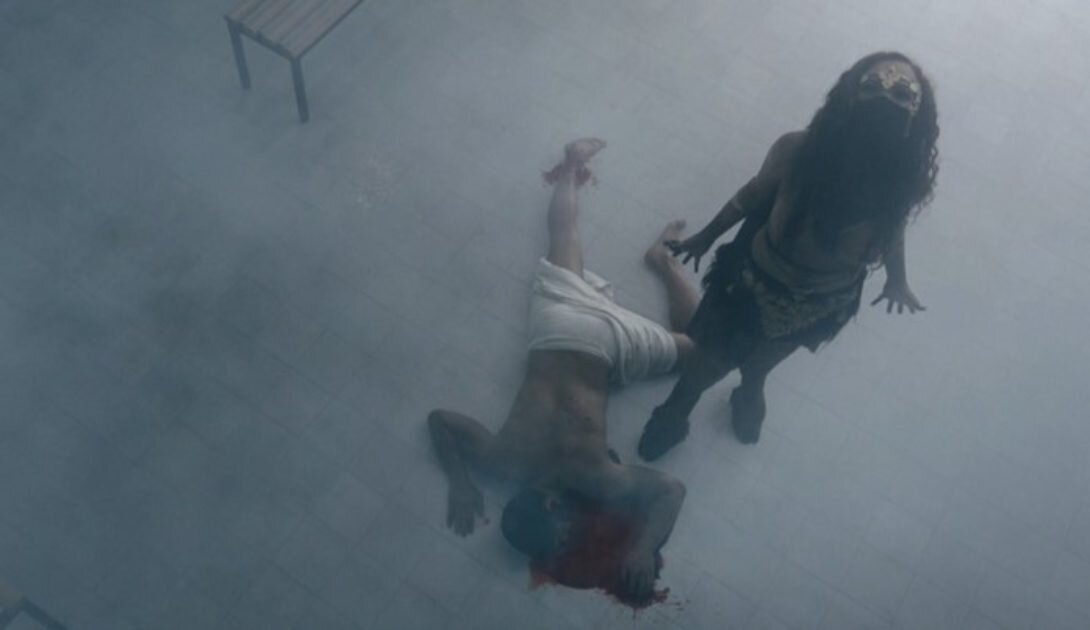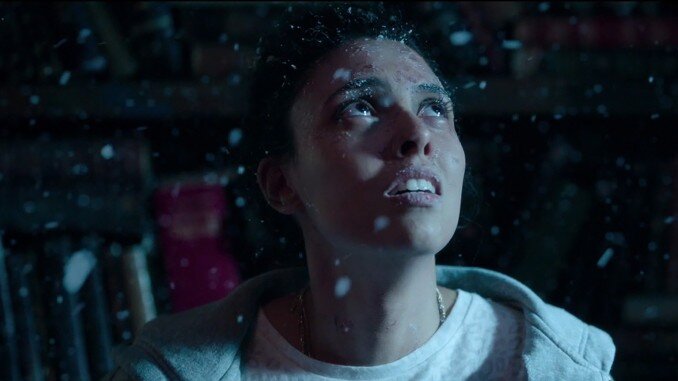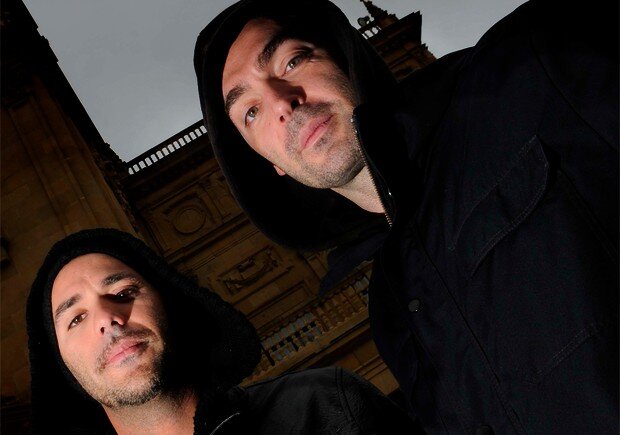[Editorial] Director Julien Maury Talks All Things Kandisha

Having watched and reviewed Kandisha recently, it was a real pleasure and privilege to talk to Julien Maury, one of the minds behind the film. The other writer-director, Alexandre Bustillo, was unavailable but that wasn’t going to get in the way of the interview; as Julien said “we’re two persons but one brain, so it’s OK.”
I asked Julien how their partnership had started. “That was long ago now,” answered Julien. “We started to work together fifteen years ago now (Inside was shot in 2006). We started in the most classical way, with a mutual friend. Alex used to be a journalist for the French Fangoria, which is called Mad Movies, a magazine about horror and fantasy; and I used to read that magazine since my youngest age, because my older brother was a fan of horror movies. When Alex was hired, I felt a connection, because I agreed with all of his choices and every movie he loved I loved as well, and I thought he was really funny. So one day I went to the DVD shop owned by the magazine and I asked the manager ‘is Alex Bustillo a cool guy? Because I love to read his articles, and I would be deceived if I learn that he is an asshole.’ And the guy said ‘I don’t know him, but he is writing scripts, and you are directing short movies: maybe it would fit between the two of you.’ That’s what happened! I called him and said ‘we don’t know each other, but this guy David thinks we can work’ and neither Alex nor I had any connection in the movie industry, so we decided we’d do things like Peter Jackson or Sam Raimi: do it with our friends, shooting in the back yard or a forest. We already had the idea for Inside and were lucky enough to find a producer, and that’s how it all started.”

Sounds like good fortune to find someone like that with similar tastes… but surely they didn’t both have the idea for Inside? That must have been like jumping in at the deep end in terms of making a first film together. “No, Alex came up with the first draft,” explained Julien. “And when I read it, I was wow! If we succeed in making such a movie in France, it’s going to be awesome! So we did it! It was the right time: at that moment, the French TV channel called Canal+ was looking for French horror movies, so it was good timing.”
The pair’s film style – especially with regard to Inside – has been described as “extreme”. I asked Julien how he felt about that label. “I don’t know. Sure, Inside was extreme, so it’s OK for that one to have the label. The other movies… well we have some gory moments, which is what we love as an audience, and so naturally it’s something we want to do as directors. So the later films aren’t extreme, but the label may have stuck since Inside. We always have an approach that can be hardcore for some people, but it’s not very dark; not like A Serbian Film and that kind of thing, not so dour or serious. I think we will always turn towards the audience and want them to have fun, enjoy the show.”
I’ve not seen Among the Living, but Inside, Livid and now Kandisha all focus on female characters. As a male writing duo, I asked how Julien and Alex go about writing relatable women for their stories. “It’s always complicated to analyse your own job, but for us, we always felt that having strong women as leads was interesting for us. We tried not to go into cliché, like Ripley in Alien or Sarah Connor in The Terminator; to us, they look like men, women acting as men. For us, we wanted to be more original and relevant. For example, in Inside, our first idea was more classical: we always saw movies with a Bogeyman and a “final girl” running, and our first draft had the idea of a man chasing a pregnant woman. Then at one point we switched: we thought if a woman was chasing a woman, that would be different, more visceral combined with the pregnancy idea. We don’t think about it when we write the story, except we like to write for women.”

Kandisha is largely made up of an unknown cast, and I asked Julien about how these terrific actors had been found. “We did a traditional casting by receiving young, promising women, and we had a casting director showed us some tapes: it was a long process, but we were determined that the three girls would be modern, and to have this ability of really easy talk. They were able to improvise and change the dialogue, because me and Alex are not tyrant directors: we don’t insist they cannot change anything in the script, but instead try to involve everyone, especially the cast. We love for the girls to bring part of themselves and something they could be proud of. We would ask them ‘for you, who is this character? Can they really say this or say that? Think like this or like that?’ That’s why we took time for the long process and were really pleased with these three girls.”
I didn’t know whether Alex or Julien had any family heritage in Morocco, so I asked what it was that had drawn them to the Aicha Kandisha legend. “No, it wasn’t from our backgrounds. It was actually Alex that told me about the legend at first, as he was living in Paris suburbs with Moroccan friends. There’s a thing we love to do: when we meet someone, we always ask him ‘what is your biggest fear? What frightens you the most?’ We are always curious, because fear is very personal. And each time he asked Moroccan people, they always, always, always answer Aicha Kandisha. That was very interesting and so we started to make some research about it and we discovered that it was a very Moroccan legend, but it is also something you can find in many other cultures: she is like a mermaid, or has wings, you can find her in ancient Greece or Asia. We felt that we could change it just a bit to bring it to life. It is based on real events that took place in sixteenth century: she was a rebel, because at this time Morocco was a Portuguese colony. She attracted soldiers to the resistance and they killed the soldiers, and the legend followed: the stories were that the soldiers were attacked with a jinn, and so she became like a jinn.”

I understand their next film, The Deep House, also has a supernatural element. I asked Julien if they preferred to carry on in this vein of horror, and have now moved away from the realism of Inside. “No, as directors we really want to explore different aspects of the genre, because as viewers, we love fantasy, pure horror, science fiction, ghost stories, monster movies. So as directors we have a lot of avenues: it’s not a wish, but random. We are always working on scripts, and you can never know when you will find the right producer, when any story is going to happen or even if. So it was random chance that we had more fantasy in The Deep House and Kandisha because we already did some fantasy in Livid, and we do still love realistic horror movies too. I’m sure we are going to come back one day to the realism.”
When this interview took place, Kandisha was about to be released as a Shudder Original. I asked Julien how he felt about that. “Of course, we are big fans of theatre and the big screen. But regarding the pandemic situation, I think we are really lucky, and the most important thing for us is that the movie can be seen. The worst scenario would have been if it was forgotten on a shelf and disappear. The movie was supposed to be released in theatres in France, but then we had the second lockdown, and so the distributors declared ‘OK this is not going to work: let’s forget about it and find another way to the audience.’ So we are really, really happy that Shudder is releasing: it is watched by our fan base, the horror fan base.”
When people think of horror films, slashers are often the first thing that comes to mind. The sub-genres also spawned a wealth of horror icons: Freddy, Jason, Michael, Chucky - characters so recognisable we’re on first name terms with them. In many ways the slasher distills the genre down to some of its fundamental parts - fear, violence and murder.
Throughout September we were looking at slasher films, and therefore we decided to cover a slasher film that could be considered as an underrated gem in the horror genre. And the perfect film for this was Franck Khalfoun’s 2012 remake of MANIAC.
In the late seventies and early eighties, one man was considered the curator of all things gore in America. During the lovingly named splatter decade, Tom Savini worked on masterpieces of blood and viscera like Dawn of the Dead (1978), a film which gained the attention of hopeful director William Lustig, a man only known for making pornography before his step into horror.
Looking for some different slasher film recommendations? Then look no fruther as Ariel Powers-Schaub has 13 non-typical slasher horror films for you to watch.
Even though they are not to my personal liking, there is no denying that slasher films have been an important basis for the horror genre, and helped to build the foundations for other sub-genres throughout the years.
But some of the most terrifying horrors are those that take place entirely under the skin, where the mind is the location of the fear. Psychological horror has the power to unsettle by calling into question the basis of the self - one's own brain.
On Saturday, 17th June 2023, I sat down with two friends to watch The Human Centipede (First Sequence) (2009) and The Human Centipede 2 (Full Sequence) (2012). I was nervous to be grossed out (I can’t really handle the idea of eating shit) but excited to cross these two films off my list.
Many of the most effective horror films involve blurring the lines between waking life and a nightmare. When women in horror are emotionally and psychologically manipulated – whether by other people or more malicious supernatural forces – viewers are pulled into their inner worlds, often left with a chilling unease and the question of where reality ends and the horror begins.
Body horror is one of the fundamental pillars of the horror genre and crops up in some form or another in a huge variety of works. There's straightforward gore - the inherent horror of seeing the body mutilated, and also more nuanced fears.
In the sweaty summer of 1989, emerging like a monochrome migraine from the encroaching shadow of Japan’s economic crash, Shin’ya Tsukamoto’s Tetsuo: The Iron Man shocked and disgusted the (very few) audiences originally in attendance.
Whether it's the havoc wreaked on the human body during pregnancy, emotional turmoil producing tiny murderous humans or simply a body turning on its owner, body horror films tend to be shocking. But while they're full of grotesque imagery, they're also full of thoughtful premises and commentary, especially when it comes to women, trauma, and power.
The human body is a thing of wonder and amazement–the way it heals itself, regenerates certain parts and can withstand pain and suffering to extreme extents. But the human body can also be a thing of disgust and revulsion–with repugnant distortions, oozing fluids and rotting viscera.
This June we’ve been looking at originals and their remakes—and whilst we don’t always agree with horror film remakes, some of them often bring a fresh perspective to the source material. For this episode, we are looking at the remake of one of the most controversial exploitation films, The Last House on the Left (2009).
The year was 1968 and a young man named George A. Romero had shot his first film, a horror movie that would change the world of cinema and not just horror cinema, at that. Night of the Living Dead (1968), would go on to become one of the most important and famous horror films of all time as it tackled not only survival horror but also very taboo and shocking topics like cannibalism and matricide.
In the end I decided to indulge myself by picking eight of my favourite shorts, and choosing features to pair with them that would work well as a double bill. The pairs might be similar in tone, subject or style; some of the shorts are clearly influenced by their paired movie, while others predate the features.

RELATED ARTICLES
Films that blend horror with romance always fascinate me; add a niche contemporary setting that I’ve never heard of before and I’m hooked. Cannibal Mukbang was made by Aimee Kuge, a young woman from New York, and I was privileged to spend a little time talking with her over Zoom…
Now it’s time for Soho’s main 2023 event, which is presented over two weekends: a live film festival at the Whirled Cinema in Brixton, London, and an online festival a week later. Both have very rich and varied programmes (with no overlap this year), with something for every horror fan.
In the six years since its release the Nintendo Switch has amassed an extensive catalogue of games, with everything from puzzle platformer games to cute farming sims to, uh, whatever Waifu Uncovered is.
A Quiet Place (2018) opens 89 days after a race of extremely sound-sensitive creatures show up on Earth, perhaps from an exterritorial source. If you make any noise, even the slightest sound, you’re likely to be pounced upon by these extremely strong and staggeringly fast creatures and suffer a brutal death.
Have I told you about Mayhem Film Festival before? It’s a favourite event of mine, so I’ve blurted about it in anticipation to many people I know. The event has just passed, so now is the time to gush its praises to those I don’t know.
Loop Track, Thomas Sainsbury’s directorial debut, has such a sparse description that it’s really difficult to know what you’re stepping into when it starts. It’s about Ian (played by the director), who is taking a trek through the New Zealand bush….
For a movie that doesn’t even mention the word “vampire” once throughout the length of the film, Near Dark (1987) is a unique entry in the vampire film genre.
If you like cults, sacrificial parties, and lesbian undertones then Mona Awad’s Bunny is the book for you. Samantha, a student at a prestigious art university, feels isolated from her cliquey classmates, ‘the bunnies’.
Kicking off on Tuesday 17th October, the 2023 edition considers the cinematic, social and cultural significance of the possessed, supernatural and unclean body onscreen.
I was aware of the COVID-19 pandemic before I knew that’s what it would be called, and before it ever affected me personally. My husband is always on top of world events, and in late 2019, he explained what was happening around the globe.
Metal and horror have many aspects in common. The passionate fanbase for both genres attend festivals and has created strong communities. Horror and Metal fans often sport clothing depicting their favourite bands or films, almost like a uniform.

EXPLORE
Now it’s time for Soho’s main 2023 event, which is presented over two weekends: a live film festival at the Whirled Cinema in Brixton, London, and an online festival a week later. Both have very rich and varied programmes (with no overlap this year), with something for every horror fan.
In the six years since its release the Nintendo Switch has amassed an extensive catalogue of games, with everything from puzzle platformer games to cute farming sims to, uh, whatever Waifu Uncovered is.
A Quiet Place (2018) opens 89 days after a race of extremely sound-sensitive creatures show up on Earth, perhaps from an exterritorial source. If you make any noise, even the slightest sound, you’re likely to be pounced upon by these extremely strong and staggeringly fast creatures and suffer a brutal death.
If you like cults, sacrificial parties, and lesbian undertones then Mona Awad’s Bunny is the book for you. Samantha, a student at a prestigious art university, feels isolated from her cliquey classmates, ‘the bunnies’.
The slasher sub genre has always been huge in the world of horror, but after the ‘70s and ‘80s introduced classic characters like Freddy Krueger, Michael Myers, Leatherface, and Jason, it’s not harsh to say that the ‘90s was slightly lacking in the icon department.
Mother is God in the eyes of a child, and it seems God has abandoned the town of Silent Hill. Silent Hill is not a place you want to visit.
Being able to see into the future or back into the past is a superpower that a lot of us would like to have. And while it may seem cool, in horror movies it usually involves characters being sucked into terrifying situations as they try to save themselves or other people with the information they’ve gleaned in their visions.
Both the original Pet Sematary (1989) and its 2019 remake are stories about the way death and grief can affect people in different ways. And while the films centre on Louis Creed and his increasingly terrible decision-making process, there’s no doubt that the story wouldn’t pack the same punch or make the same sense without his wife, Rachel.


![[Editorial] 5 Slasher Short Horror Films](https://images.squarespace-cdn.com/content/v1/5fe76a518d20536a3fbd7246/1696358009946-N8MEV989O1PAHUYYMAWK/Screenshot+2023-10-03+at+19.33.19.png)
![[Ghouls Podcast] Maniac (2012) with Zoë Rose Smith and Iona Smith](https://images.squarespace-cdn.com/content/v1/5fe76a518d20536a3fbd7246/1696356006789-NYTG9N3IXCW9ZTIJPLX2/maniac.jpg)
![[Editorial] If Looks Could Kill: Tom Savini’s Practical Effects in Maniac (1980)](https://images.squarespace-cdn.com/content/v1/5fe76a518d20536a3fbd7246/1694952175495-WTKWRE3TYDARDJCJBO9V/Screenshot+2023-09-17+at+12.57.55.png)
![[Editorial] Deeper Cuts: 13 Non-Typical Slashers](https://images.squarespace-cdn.com/content/v1/5fe76a518d20536a3fbd7246/1694951568990-C37K3Z3TZ5SZFIF7GCGY/Curtains-1983-Lesleh-Donaldson.jpg)
![[Editorial] Editor’s Note: Making a slash back into September](https://images.squarespace-cdn.com/content/v1/5fe76a518d20536a3fbd7246/1694354202849-UZE538XIF4KW0KHCNTWS/MV5BMTk0NTk2Mzg1Ml5BMl5BanBnXkFtZTcwMDU2NTA4Nw%40%40._V1_.jpg)
![[Editorial] 8 Mind Horror Short films](https://images.squarespace-cdn.com/content/v1/5fe76a518d20536a3fbd7246/1693504844681-VPU4QKVYC159AA81EPOW/Screenshot+2023-08-31+at+19.00.36.png)
![[Editorial] Eat Shit and Die: Watching The Human Centipede (2009) in Post-Roe America ](https://images.squarespace-cdn.com/content/v1/5fe76a518d20536a3fbd7246/1691245606758-4W9NZWE9VZPRV697KH5U/human_centipede_first_sequence.original.jpg)
![[Editorial] Top 15 Female-Focused Mind Horror Films](https://images.squarespace-cdn.com/content/v1/5fe76a518d20536a3fbd7246/1691247166903-S47IBEG7M69QXXGDCJBO/Image+5.jpg)
![[Editorial] 8 Body Horror Short films](https://images.squarespace-cdn.com/content/v1/5fe76a518d20536a3fbd7246/1690838270920-HWA5RSA57QYXJ5Y8RT2X/Screenshot+2023-07-31+at+22.16.28.png)
![[Editorial] Metal Heart: Body Dysmorphia As A Battle Ground In Tetsuo: The Iron Man (1989)](https://images.squarespace-cdn.com/content/v1/5fe76a518d20536a3fbd7246/1690190127461-X6NOJRAALKNRZY689B1K/Screenshot+2023-07-24+at+10.08.27.png)
![[Editorial] Top 15 Female-Focused Body Horror Films](https://images.squarespace-cdn.com/content/v1/5fe76a518d20536a3fbd7246/1689081174887-XXNGKBISKLR0QR2HDPA7/download.jpeg)
![[Editorial] Editor’s Note: Getting sticky, slimy & sexy with body horror](https://images.squarespace-cdn.com/content/v1/5fe76a518d20536a3fbd7246/1689072388373-T4UTVPVEEOM8A2PQBXHY/Society-web.jpeg)
![[Ghouls Podcast] The Last House on the Left (2009) with Zoë Rose Smith and Jerry Sampson](https://images.squarespace-cdn.com/content/v1/5fe76a518d20536a3fbd7246/1687863043713-54DU6B9RC44T2JTAHCBZ/last+house+on+the+left.jpg)
![[Editorial] They’re Coming to Re-Invent You, Barbara! Night of the Living Dead 1968 vs Night of the Living Dead 1990](https://images.squarespace-cdn.com/content/v1/5fe76a518d20536a3fbd7246/1687199945212-BYWYXNBSH00C4V3UIOFQ/Screenshot+2023-06-19+at+19.05.59.png)
![[Editorial] 8 Short & Feature Horror Film Double Bills](https://images.squarespace-cdn.com/content/v1/5fe76a518d20536a3fbd7246/1687770541477-2A8J2Q1DI95G8DYC1XLE/maxresdefault.jpeg)
![[Editorial] Soho Horror Film Festival: Interview with Aimee Kuge on Cannibal Mukbang](https://images.squarespace-cdn.com/content/v1/5fe76a518d20536a3fbd7246/1701808004722-9M8SZ2UXY52QBQBR4NTI/img20230818_15150780.JPG)
![[Editorial] 10 Films & Events to Catch at Soho Horror Film Fest 2023](https://images.squarespace-cdn.com/content/v1/5fe76a518d20536a3fbd7246/1700819417135-299R7L4P0B676AD3RO1X/Screenshot+2023-11-24+at+09.41.52.png)
![[Editorial] 9 Horror Nintendo Switch Games To Play](https://images.squarespace-cdn.com/content/v1/5fe76a518d20536a3fbd7246/1697214470057-3XZXX8N4LYIMDFWS6Z3P/Screenshot+2023-10-13+at+17.20.13.png)
![[Mother of Fears] Mothering in Silence in A Quiet Place (2018)](https://images.squarespace-cdn.com/content/v1/5fe76a518d20536a3fbd7246/1696445921315-HZJ2DZYQIH6VVWXBO2YL/Screenshot+2023-10-04+at+19.52.29.png)
![[Event Review] Highlights from Mayhem Film Festival 2023](https://images.squarespace-cdn.com/content/v1/5fe76a518d20536a3fbd7246/1697624582491-MPT2VB9RRGU6OG7L6UKL/Mayhem+2023.jpg)
![[Editorial] Mayhem Festival: Interview with Thomas Sainsbury on Loop Track (2023)](https://images.squarespace-cdn.com/content/v1/5fe76a518d20536a3fbd7246/1697186472899-WC4RR0TW7L7LMFEBGPA2/Tom+Sainsbury.jpg)
![[Editorial] Keeping Odd Hours: A Retrospective on Near Dark (1987)](https://images.squarespace-cdn.com/content/v1/5fe76a518d20536a3fbd7246/1696445070868-HU9YIL3QPBCL1GW47R3Z/Screenshot+2023-10-04+at+19.36.53.png)
![[Editorial] 5 Female Focused Horror Book Recommendations](https://images.squarespace-cdn.com/content/v1/5fe76a518d20536a3fbd7246/1696441981361-52EQCTJ7AT2QF1927GM7/919xtm6d3fL._AC_UF894%2C1000_QL80_.jpg)
![[Editorial] What to Watch at This Year's Cine-Excess International Film Festival 2023](https://images.squarespace-cdn.com/content/v1/5fe76a518d20536a3fbd7246/1697213510960-REV43FEOZITBD2W8ZPEE/Screenshot+2023-10-13+at+17.01.15.png)
![[Editorial] Cherish Your Life: Comfort in the SAW Franchise Throughout and Beyond the COVID-19 Pandemic](https://images.squarespace-cdn.com/content/v1/5fe76a518d20536a3fbd7246/1695487675334-MYPCPYYZQZDCT548N8DI/Sc6XRxgSqnMEq54CwqjBD5.jpg)
![[Editorial] The Art of Horror in Metal](https://images.squarespace-cdn.com/content/v1/5fe76a518d20536a3fbd7246/1695486401299-E5H2JNNJT26HKN0CI7WC/Screenshot+2023-09-23+at+17.20.28.png)





















![[Editorial] 9 Best Slashers Released Within 10 Years of Scream (1996)](https://images.squarespace-cdn.com/content/v1/5fe76a518d20536a3fbd7246/1695478839037-LOFHGVM3H6BMSZW7G83M/Screenshot+2023-09-23+at+15.15.11.png)
![[Mother of Fears] Mother Vs. Monster in Silent Hill (2006)](https://images.squarespace-cdn.com/content/v1/5fe76a518d20536a3fbd7246/1695485781119-H6GNP0G3J2TLPAOIABV7/Screenshot+2023-09-23+at+17.11.56.png)
![[Editorial] 9 Terrifying Cerebral Visions in Horror Movies](https://images.squarespace-cdn.com/content/v1/5fe76a518d20536a3fbd7246/1693509801235-X23OL50T1DVGECH0ZJK2/MV5BMjQ0MTg2MjQ4MV5BMl5BanBnXkFtZTgwMTU3NDgxMTI%40._V1_.jpg)
![[Mother of Fears] I Don’t Wanna Be Buried in a Pet Sematary (1989) and (2019)](https://images.squarespace-cdn.com/content/v1/5fe76a518d20536a3fbd7246/1691328766069-QFNAVJOMFZVZ5CLU1RWM/Screenshot+2023-08-06+at+14.23.13.png)

I can sometimes go months without having a panic attack. Unfortunately, this means that when they do happen, they often feel like they come out of nowhere. They can come on so fast and hard it’s like being hit by a bus, my breath escapes my body, and I can’t get it back.